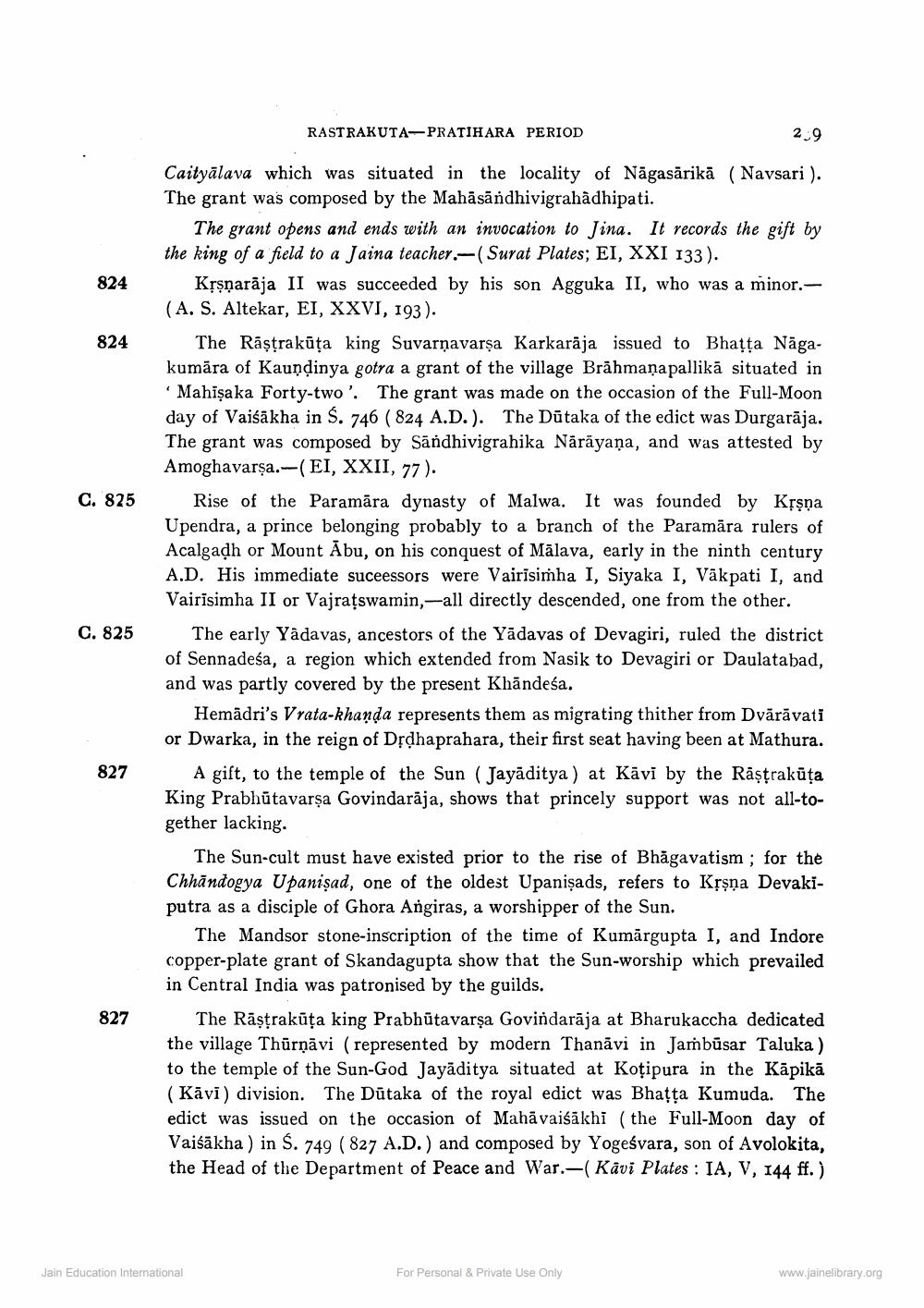________________
824
824
C. 825
C. 825
827
827
RASTRAKUTA-PRATIHARA PERIOD
Caityālava which was situated in the locality of Nagasarikā (Navsari). The grant was composed by the Mahāsāndhivigrahadhipati.
2.9
The grant opens and ends with an invocation to Jina. It records the gift by the king of a field to a Jaina teacher.-(Surat Plates; EI, XXI 133).
Krsparāja II was succeeded by his son Agguka II, who was a minor.(A. S. Altekar, EI, XXVI, 193).
The Rastrakūta king Suvarnavarsa Karkarāja issued to Bhatta Nāgakumāra of Kaundinya gotra a grant of the village Brāhmaṇapallikä situated in 'Mahişaka Forty-two. The grant was made on the occasion of the Full-Moon day of Vaisakha in S. 746 (824 A.D.). The Dutaka of the edict was Durgarāja. The grant was composed by Sandhivigrahika Nārāyaṇa, and was attested by Amoghavarṣa.-(EI, XXII, 77).
Rise of the Paramāra dynasty of Malwa. It was founded by Krsna Upendra, a prince belonging probably to a branch of the Paramāra rulers of Acalgadh or Mount Abu, on his conquest of Malava, early in the ninth century A.D. His immediate suceessors were Vairīsimha I, Siyaka I, Vākpati I, and Vairīsimha II or Vajratswamin,-all directly descended, one from the other.
The early Yadavas, ancestors of the Yadavas of Devagiri, ruled the district of Sennadesa, a region which extended from Nasik to Devagiri or Daulatabad, and was partly covered by the present Khandesa.
Hemadri's Vrata-khanda represents them as migrating thither from Dvārāvati or Dwarka, in the reign of Drdhaprahara, their first seat having been at Mathura.
A gift, to the temple of the Sun (Jayaditya) at Kävi by the Răştrakūta King Prabhutavarṣa Govindaraja, shows that princely support was not all-together lacking.
The Sun-cult must have existed prior to the rise of Bhagavatism; for the Chhandogya Upanisad, one of the oldest Upanisads, refers to Krsna Devakiputra as a disciple of Ghora Angiras, a worshipper of the Sun.
The Mandsor stone-inscription of the time of Kumärgupta I, and Indore copper-plate grant of Skandagupta show that the Sun-worship which prevailed in Central India was patronised by the guilds.
Jain Education International
The Rastrakūta king Prabhutavarsa Govindaraja at Bharukaccha dedicated the village Thürṇāvi (represented by modern Thanavi in Jambusar Taluka) to the temple of the Sun-God Jayaditya situated at Kotipura in the Käpikā (Kāvi) division. The Dutaka of the royal edict was Bhatta Kumuda. The edict was issued on the occasion of Mahāvaiśākhi (the Full-Moon day of Vaisakha) in S. 749 (827 A.D.) and composed by Yogeśvara, son of Avolokita, the Head of the Department of Peace and War.- Kavi Plates: IA, V, 144 ff.)
For Personal & Private Use Only
www.jainelibrary.org




